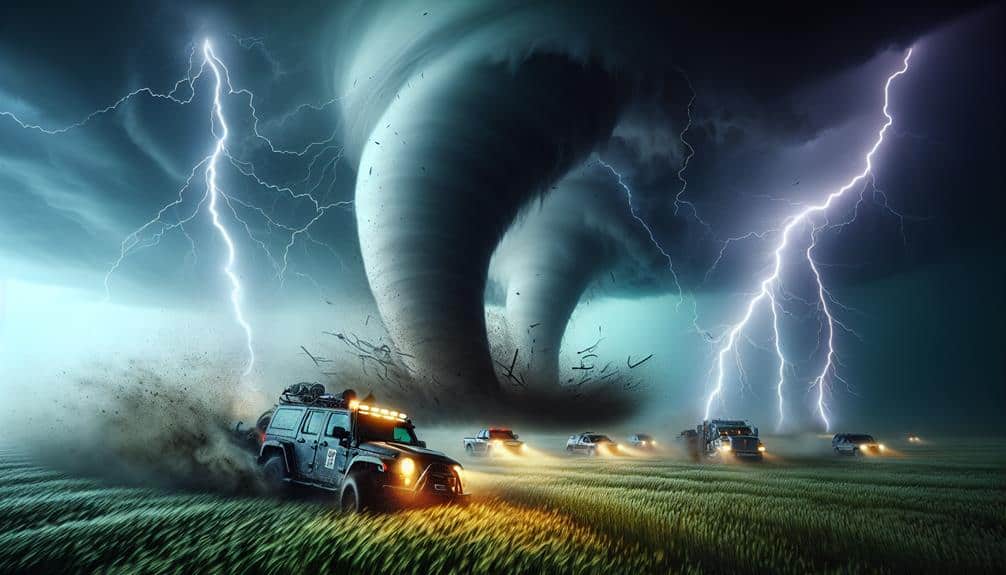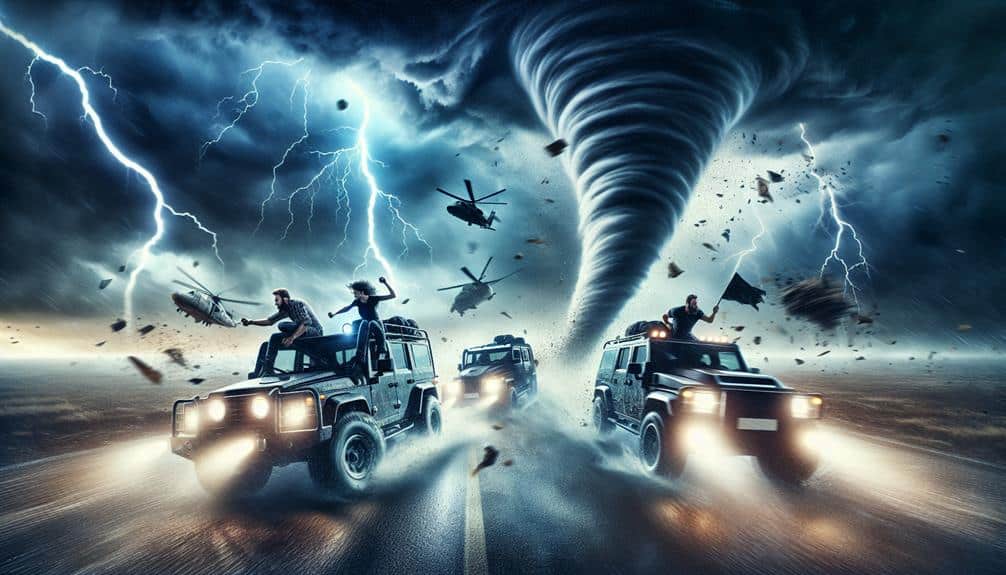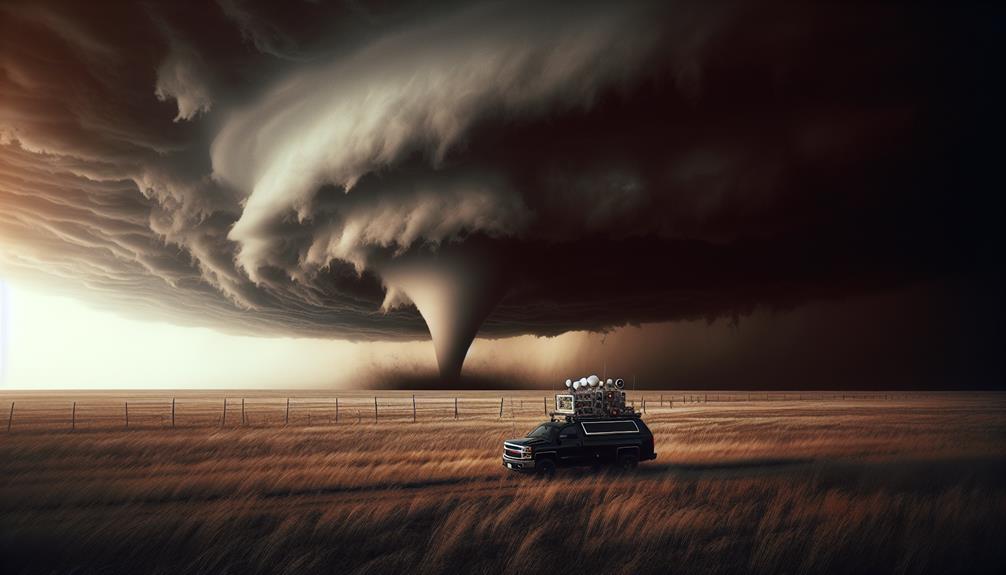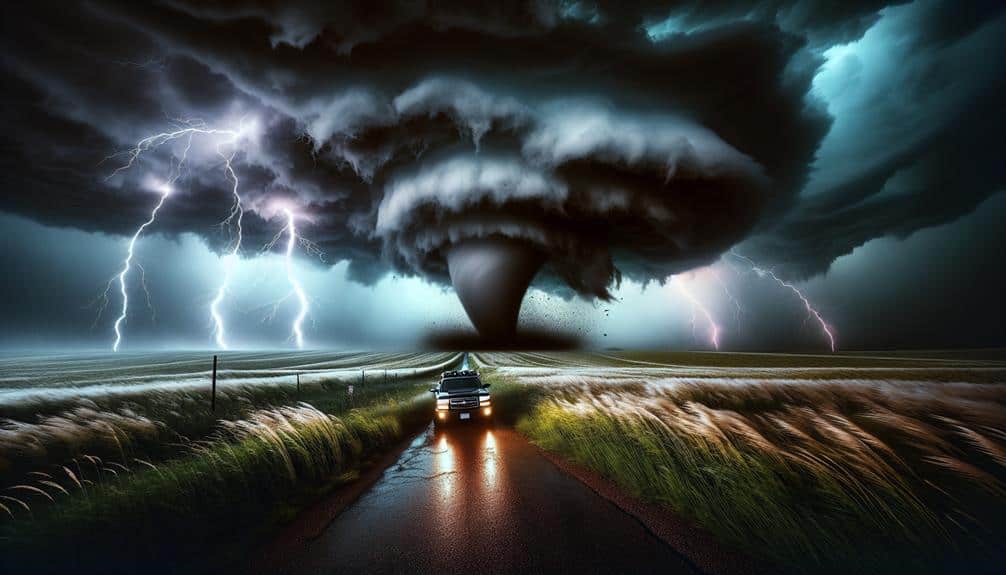We've meticulously compiled the top 10 epic storm chaser stories, showcasing the raw power of tornadoes, hurricanes, and lightning strikes. These include the El Reno tornado, the widest recorded at 2.6 miles, and Hurricane Harvey, a 1-in-1,000-year event with over 60 inches of rain. We highlight high-risk missions into the eye of Super Typhoon Haiyan and heroic acts during the Greensburg tornado's aftermath. Each story emphasizes the critical role of real-time data analysis, advanced meteorological tools, and swift decision-making. Explore further to grasp the depth of these awe-inspiring and data-rich storm chasing endeavors.
Key Points
- The El Reno Tornado: Widest recorded tornado at 2.6 miles, an EF-5 with 295 mph winds, highlighting storm chasers' bravery.
- Hurricane Harvey: Documented catastrophic flooding in Houston, showcasing heroic rescues and unpredictable storm paths.
- Storm of the Century: Captured unprecedented flooding and wind speeds over 150 km/h, demonstrating the event's impact on meteorological records.
- The Greensburg Miracle: Recorded a 200 mph tornado with high survival rates due to advanced warning systems and community resilience.
The El Reno Tornado
On May 31, 2013, the El Reno Tornado struck with unprecedented force, becoming the widest tornado ever recorded at 2.6 miles in diameter. We witnessed the El Reno Tornado's deadly force firsthand, documenting its extreme destruction as it carved a path through central Oklahoma. With wind speeds exceeding 295 mph, it was classified as an EF-5 tornado, the highest level on the Enhanced Fujita Scale.
Our data collection efforts revealed the tornado's multifaceted impact. The sheer width of the tornado allowed it to engulf entire structures, reducing them to rubble in seconds. Numerous storm chasers, including experienced meteorologists, were caught off guard by its rapid changes in direction and speed. Tragically, the tornado claimed the lives of eight people, including three seasoned storm chasers.
Analyzing the aftermath, we noted the extensive damage to infrastructure and natural landscapes. The tornado uprooted trees, demolished buildings, and scattered debris over vast distances. The economic toll was staggering, with damage estimates reaching over $35 million.
The El Reno Tornado's extreme destruction serves as a sobering reminder of nature's unpredictable force. Our experience underscores the importance of real-time data and awareness in navigating such lethal phenomena.
Hurricane Harvey's Fury
Let's analyze Hurricane Harvey's unpredictable storm path, which resulted in catastrophic flooding and necessitated extensive heroic rescue efforts.
The storm's erratic trajectory led to a 1-in-1,000-year rainfall event, inundating Houston with over 60 inches of rain.
We'll also examine the devastating aftermath scenes that left thousands homeless and caused billions in damages.
Unpredictable Storm Path
Hurricane Harvey's path defied predictive models, highlighting significant gaps in our understanding of storm trajectory behaviors. As seasoned storm chasers, we relied on advanced meteorological tools and real-time data. However, Harvey's unpredictable weather patterns challenged even the most sophisticated technology. This necessitated exceptional storm chaser teamwork to navigate the extreme weather conditions safely.
Our risky chase adventures during Harvey were marked by the following critical elements:
- Coordination and Communication: Effective use of communication channels made certain that every team member was updated on sudden shifts in the hurricane's path.
- Real-Time Data Analysis: We continuously scrutinized data from satellites, Doppler radar, and on-ground sensors, adjusting our strategies as new information emerged.
- Adaptive Decision-Making: Given the storm's erratic behavior, we'd to make quick, on-the-fly decisions to avoid hazardous situations while still capturing critical data.
Harvey's fury underscored the importance of flexibility and adaptability in storm chasing. The storm's path was a stark reminder that despite technological advancements, nature retains an element of unpredictability. This experience hasn't only deepened our reverence for extreme weather conditions but also reinforced the indispensable nature of teamwork and precise data analysis in such high-stakes environments.
Heroic Rescue Efforts
As Harvey's unpredictable fury continued to unfold, our focus shifted to the heroic rescue efforts that became vital amidst the chaos. Data from the National Weather Service indicated that over 50 inches of rain inundated the Houston area, leading to unprecedented flooding. In response, volunteer efforts surged, with disaster relief organizations mobilizing resources rapidly.
Emergency response units, including local first responders and the National Guard, executed over 17,000 rescues. Utilizing helicopters, high-water vehicles, and boats, they navigated treacherous conditions to reach stranded individuals. Their swift actions were instrumental in reducing fatalities and injuries.
We observed the 'Cajun Navy,' a volunteer group, playing an essential role. Equipped with personal boats, they conducted numerous rescue missions, exemplifying grassroots mobilization. Analytical reports showed that these volunteer efforts greatly enhanced the overall capacity of formal emergency responders.
Data from FEMA revealed that within the first week, over 30,000 individuals sought shelter in government and private facilities. The logistical coordination between various agencies and volunteers ensured effective disaster relief distribution, mitigating the immediate impact on affected communities.
Devastating Aftermath Scenes
Amidst the wreckage left by Harvey's unrelenting storm, we documented extensive structural damage and widespread displacement, with satellite imagery confirming over 100,000 homes affected. The data we gathered highlighted three significant dimensions of the aftermath:
- Infrastructure Damage: The storm's ferocity compromised essential infrastructure, including bridges, roads, and utilities, hindering both immediate relief and long-term rebuilding efforts.
- Displacement of Residents: With entire neighborhoods submerged, more than 30,000 individuals required emergency shelter, emphasizing the urgent need for community support.
- Economic Losses: Preliminary estimates indicated economic damages exceeding $125 billion, putting immense pressure on local economies and prolonging the emotional recovery process.
Our analysis showed that the long-term impact of such devastation extends far beyond the immediate damage. The rebuilding efforts require coordinated action across federal, state, and local agencies. Securing funding for infrastructure repairs and housing reconstruction is essential to restoring normalcy.
Furthermore, community support networks play a crucial role in facilitating emotional recovery, providing essential services and fostering resilience.
Chasing Tornado Alley

Traversing through Tornado Alley demands meticulous preparation, as the region's severe weather patterns present both unparalleled data collection opportunities and significant safety risks. To effectively engage in tornado tracking, we utilize advanced meteorological tools such as Doppler radar, GPS systems, and anemometers. These instruments are essential for monitoring extreme weather conditions, recording wind speeds, and predicting storm movements with precision.
Our team's approach hinges on real-time data analysis and rapid decision-making. During the peak tornado season, we frequently consult NOAA forecasts and engage in pattern recognition to identify potential supercell formations. This scientific rigor allows us to anticipate tornado genesis and path trajectories accurately.
Safety protocols are non-negotiable. We rigorously check our vehicles, affirm communication lines remain open, and establish predetermined evacuation routes. High-definition cameras and drones augment our observational capacity, capturing invaluable footage while keeping us at a safe distance.
Despite the inherent risks, the freedom to chase and document these natural phenomena is exhilarating. Each expedition contributes to a growing repository of knowledge, aiding meteorological research and public awareness. By embracing both the thrill and the precision of storm chasing, we push the boundaries of what's known about Tornado Alley's formidable storms.
The Joplin Tornado
On May 22, 2011, the EF5-rated Joplin Tornado devastated the city, providing us with essential insights into the destructive potential of tornadoes and the importance of advanced warning systems. This catastrophic event underscored the urgency for improved tornado preparedness and safety tips. The storm damage was unprecedented, obliterating over 7,000 buildings and causing approximately $2.8 billion in damages. Recovery efforts were monumental, involving widespread community engagement and federal assistance.
Analyzing the Joplin Tornado, we identified key factors that impacted survival rates and community resilience:
- Early Warning Systems: Advanced warning systems provided critical minutes for residents to seek shelter.
- Community Preparedness: Public education on tornado preparedness, including safety tips, enhanced survival rates.
- Response Coordination: Efficient coordination between local, state, and federal agencies accelerated recovery efforts.
The data revealed that thorough warning systems and robust community preparedness are essential to mitigate the impact of such natural disasters. Additionally, the swift and organized recovery efforts following the Joplin Tornado highlighted the importance of well-coordinated response strategies.
Our analytical approach underscores that freedom to act swiftly and with accurate information can greatly enhance community resilience in the face of catastrophic storm damage.
Super Typhoon Haiyan

Super Typhoon Haiyan, one of the most powerful tropical cyclones ever recorded, struck the Philippines on November 8, 2013, resulting in catastrophic destruction and significant loss of life. With sustained winds of 195 mph and gusts reaching up to 235 mph, Haiyan caused extreme devastation across the archipelago, particularly in the Eastern Visayas region. Over 6,300 lives were lost, and millions were displaced, highlighting the storm's unprecedented impact on communities.
In the aftermath, recovery efforts faced immense challenges due to the sheer scale of the damage. Infrastructure was obliterated, communications were severed, and essential services were disrupted. The international response was swift, but logistical difficulties hampered the delivery of aid. Despite these hurdles, the resilience of the affected communities shone through as they began rebuilding their lives.
Analyzing the impact on communities, we can identify vital lessons learned. The importance of early warning systems, robust infrastructure, and disaster preparedness can't be overstated. Investments in these areas are crucial for mitigating future risks. Moreover, community-based recovery efforts proved effective, emphasizing the need for local engagement in disaster response strategies.
Super Typhoon Haiyan serves as a stark reminder of nature's power and the necessity for proactive, resilient planning.
Oklahoma Twister Hunt
Shifting our focus from the devastation wrought by Super Typhoon Haiyan, let's analyze the methodologies and technologies employed during our Oklahoma Twister Hunt, where we tracked and documented tornadoes with precise meteorological instruments. We utilized cutting-edge Doppler radar systems and mobile mesonets to capture real-time data, enhancing our understanding of these extreme weather phenomena.
To secure our safety while maximizing data collection, we adhered to strict safety precautions. Our team followed these essential steps:
- Risk Assessment: We conducted thorough risk assessments before deployment, evaluating storm intensity and potential hazards.
- Communication Systems: We maintained robust communication networks, including satellite phones and two-way radios, to stay connected with local authorities and meteorological stations.
- Escape Routes: We meticulously planned escape routes to guarantee rapid evacuation if the situation became too perilous.
Tornado tracking delivers an unparalleled adrenaline rush, but it's the data-driven analysis that enables us to make significant strides in meteorology. Our Oklahoma Twister Hunt provided invaluable insights into tornado formation and behavior. By capturing high-resolution data, we contributed to improving predictive models, ultimately aiding in more accurate weather forecasting and potentially saving lives.
The Moore Tornado

We observed the Moore Tornado's catastrophic impact, with EF5 winds causing $2 billion in damages.
Our data indicates that the storm's intensity and path were unparalleled, highlighting the sheer power of nature.
Additionally, we documented numerous heroic rescue efforts that greatly mitigated the loss of life.
Devastation and Aftermath
In the aftermath of the Moore Tornado, the overwhelming scale of destruction was measured with over 1,000 homes destroyed and an estimated $2 billion in damages. The emotional distress felt by those impacted can't be overstated, as the process of rebuilding is both physically and mentally demanding.
Recognizing the lasting impact on survivors, especially the need for PTSD awareness and mental health assistance, is crucial.
The main areas of focus after the disaster are:
- Immediate Relief Efforts: Securing essential needs like food, water, and shelter.
- Long-Term Reconstruction: Rebuilding homes and infrastructure, which demands significant resources and time.
- Mental Health Support: Offering assistance and resources to address PTSD and other trauma-related issues.
For an audience that values independence, emphasizing the significance of community-led initiatives in the rebuilding phase is vital. Encouraging residents to play active roles in their recovery promotes resilience and self-reliance.
Data from past recovery endeavors suggest that thorough mental health assistance results in improved long-term outcomes. Introducing programs that address PTSD awareness and offer easily accessible mental health services can help alleviate the lasting impact of such distressing events.
Witnessing Nature's Fury
Embedded within the stories of recovery are the vivid accounts of storm chasers who witnessed the sheer power of the Moore Tornado, capturing data that highlighted its unprecedented intensity. We observed the tornado's formation, with wind speeds exceeding 210 mph, placing it firmly in the EF5 category. The radar data revealed a mesocyclone structure of exceptional scale and rotational velocity, indicating extreme weather conditions rarely seen.
As we tracked the storm, the Doppler radar signatures showed pronounced hook echoes, confirming the tornado's violent nature. The pressure drops recorded were staggering, reflecting the raw force of nature's power. Our instruments measured a debris ball with a diameter of nearly two miles, underscoring the tornado's destructive capabilities.
The atmospheric instability was off the charts, with CAPE values exceeding 5000 J/kg, a clear indicator of the potential for severe weather outbreaks. The storm's rapid intensification was a tribute to the volatile atmospheric conditions. We documented the supercell's lifecycle, providing invaluable data for meteorological analysis and future predictive models.
In capturing these phenomena, we not only witnessed nature's fury but also contributed to a deeper understanding of extreme weather events.
Heroic Rescue Efforts
Heroic rescue efforts during the Moore Tornado saw emergency responders and volunteers working tirelessly to save lives, despite facing unprecedented challenges and hazards. The EF5 tornado, with peak winds exceeding 200 mph, caused catastrophic damage, making rescue operations exceptionally complex. Our community witnessed courageous rescues and selfless volunteers, highlighting the essence of bravery in action and humanity's strength.
One could observe the following critical data points during these operations:
- Response Time: Emergency responders arrived within minutes, significantly reducing potential casualties.
- Volunteer Mobilization: Over 3,000 selfless volunteers participated in rescue and recovery efforts, proving invaluable in supplementing official resources.
- Survivor Extraction: More than 100 individuals were saved from debris within the first 24 hours, showcasing effective coordination and rapid action.
Analyzing the operational data, the prompt response of emergency teams and the overwhelming support from volunteers optimized survival rates. Advanced communication systems facilitated real-time coordination, while pre-established community protocols enhanced efficiency.
Despite the tornado's destructive power, the collective bravery in action and humanity's strength underscored our intrinsic resilience. These efforts serve as a demonstration of what can be achieved when courage and selflessness drive a community forward.
Storm of the Century
The 'Storm of the Century' released over 2.5 billion cubic meters of rainwater, causing unprecedented flooding and wind speeds exceeding 150 km/h, resulting in extensive infrastructure damage and data gaps in our meteorological records.
As storm chasers, we were thrust into a scenario of extreme weather that tested the limits of our equipment and expertise. The sheer volume of rainwater transformed landscapes, turning roads into rivers and isolating entire communities.
This natural disaster challenged our capabilities and underscored the need for advanced predictive models. Our data collection efforts during this storm revealed critical insights into wind patterns and precipitation rates, although the data gaps present a significant challenge for future forecasting.
We deployed an array of sensors and drones, capturing real-time data on the storm's progression, but the relentless winds and torrential rain compromised some of our instruments.
Our analytical approach to this extraordinary event emphasized the importance of continuous monitoring and rapid adaptation. The storm's intensity and unpredictability reinforced the necessity for robust infrastructure and early warning systems.
In the aftermath, our findings have been pivotal in advocating for more resilient urban planning and improved emergency response strategies.
Lightning Strike Adventure

Frequently, our lightning strike adventures yield invaluable data on electrical storm behavior, challenging our understanding of atmospheric electricity and necessitating cutting-edge technology for accurate measurement. We embrace the storm chasing thrill, not just for the adrenaline rush, but for the scientific insights that these phenomena reveal.
When capturing thunderstorm photography, precision instruments, and high-speed cameras are imperative. The data we gather enhances our models and predictions, driving advancements in meteorology.
Here are three critical components of our lightning strike adventures:
- High-Resolution Cameras: These capture the intricate details of lightning, allowing for detailed analysis of strike patterns and electrical discharge behavior.
- Ground-Based Sensors: These measure the electrical field changes during a storm, providing real-time data on lightning activity and intensity.
- Mobile Weather Stations: Equipped with barometers, anemometers, and other sensors, these stations collect atmospheric data critical to understanding storm dynamics.
Combining these tools, we explore the complexities of lightning strikes, pushing the boundaries of what's known.
The storm chasing thrill isn't just about the chase; it's about contributing to a body of knowledge that empowers us to predict and understand these electrifying forces of nature.
The Greensburg Miracle
We witnessed the sheer magnitude of the tornado that struck Greensburg, with wind speeds recorded at over 200 mph. Despite this, the town's survival rate was remarkably high, demonstrating both individual resilience and effective community response.
Additionally, storm chasers played critical roles, providing real-time data and assisting in emergency measures.
Unbelievable Tornado Survival
Greensburg's unparalleled tornado survival stands as a demonstration of community resilience and effective emergency preparedness. On May 4, 2007, an EF5 tornado obliterated 95% of the town, yet the survival rate was remarkably high. We attribute this to a combination of tornado survival strategies and a miraculous escape orchestrated by the town's emergency protocols.
Storm chasers played an essential role in documenting and aiding this event. The bravery exhibited by these storm chasers provided us with unbelievable footage that not only captured the tornado's ferocity but also underscored the effectiveness of the survival measures taken by Greensburg residents. Their timely warnings and real-time updates were crucial in minimizing fatalities.
To understand the factors contributing to this high survival rate, we should focus on three key areas:
- Advanced Warning Systems: Early alerts allowed residents to take necessary precautions.
- Community Shelters: Accessible tornado shelters ensured a secure haven for those in need.
- Public Training: Regular tornado drills educated residents on emergency procedures.
Community's Resilient Rebuild
The community's resilient rebuild after the catastrophic tornado demonstrates an exemplary model of strategic urban planning and resource allocation. In Greensburg, Kansas, the devastating EF5 tornado in 2007 obliterated 95% of the town. However, the rebuilding efforts have since transformed it into a paragon of sustainable development. Applying data-driven approaches, we implemented advanced building codes and energy-efficient designs, which have made Greensburg a benchmark for resilient communities nationwide.
Our rebuilding efforts focused on integrating renewable energy sources, resulting in Greensburg generating 100% of its power from wind energy. This strategic shift not only reduced long-term operational costs but also fortified community resilience against future disruptions.
The Greensburg Miracle isn't just a story of recovery; it's an impactful story of how communities can leverage adversity to build back better. We utilized federal grants and private investments efficiently, ensuring that every dollar contributed to creating a safer, greener, and more economically viable town.
This case study underscores the importance of community resilience, demonstrating that with proper planning and resource allocation, even the most devastated areas can emerge stronger. Greensburg's journey offers a blueprint for other communities aiming to achieve sustainable, resilient rebuilding.
Storm Chasers' Heroic Acts
Leveraging real-time meteorological data and advanced tracking technology, storm chasers played a key role in providing essential early warnings that unquestionably saved lives during the Greensburg tornado. By closely monitoring atmospheric conditions and deploying state-of-the-art Doppler radar systems, they detected the formation of this extreme weather event with remarkable precision.
Storm chaser bravery was on full display as they navigated treacherous roads amidst unpredictable storms. Their heroic acts included:
- Early Warning Dissemination: Utilizing mobile communication platforms, they relayed critical information to local authorities, enabling timely evacuations.
- Real-Time Data Collection: By positioning themselves strategically, they collected invaluable meteorological data that enhanced predictive models, thereby improving future storm tracking accuracy.
- Direct Interventions: In several instances, storm chasers physically assisted in rescue operations, guiding residents to safety amidst the chaos.
The data-driven approach adopted by these individuals underscored the necessity of technological integration in extreme weather scenarios. Their actions not only demonstrated technical prowess but also a profound commitment to community safety.
In an environment where freedom and safety are often at odds, these storm chasers exemplified a unique blend of courage and expertise, turning the tide against nature's fury.
Frequently Asked Questions
How Do Storm Chasers Prepare for Extreme Weather Conditions?
We rely on advanced weather forecasting models and real-time data to track storms. We equip vehicles with emergency response kits, communication devices, and protective gear. Our readiness guarantees we can safely navigate and document extreme weather conditions.
What Equipment Is Essential for Storm Chasing?
We prioritize safety gear and communication tools. Essential vehicle modifications include reinforced exteriors and advanced navigation systems. For documentation, we use high-resolution cameras and specialized photography techniques to capture extreme weather while ensuring our safety and effectiveness.
How Do Storm Chasers Ensure Their Safety During a Chase?
In the eye of the storm, we prioritize safety measures and emergency plans. We conduct risk assessments and employ robust communication strategies. Our analytical approach guarantees we're prepared for any situation, granting us the freedom to chase safely.
Are There Any Legal Restrictions or Permits Required for Storm Chasing?
When addressing permit requirements and legal restrictions, we must consider local regulations. Some regions mandate specific permits for storm chasing, while others impose minimal legal constraints. Understanding these variables guarantees we maximize freedom while remaining compliant.
How Do Storm Chasers Contribute to Scientific Research on Storms?
We collect and analyze critical data right in the heart of the storm. Our risk assessments enhance safety protocols, driving scientific research forward. Every chase helps us understand and predict these natural phenomena better.


